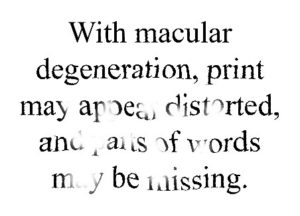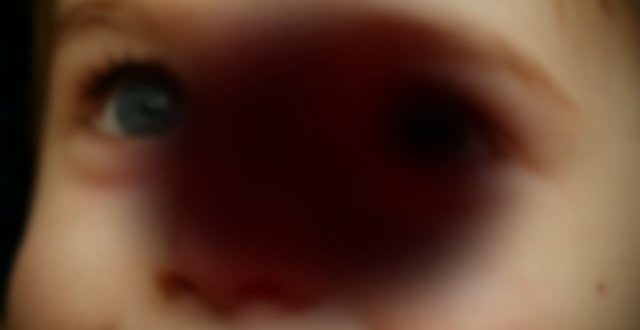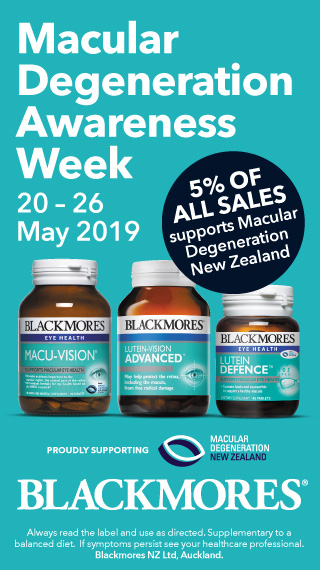What is macular degeneration?
Age related macular degeneration (MD) is the leading cause of vision loss in NZ for individuals over the age of 50 years accounting for 49% of blind registrations in NZ.
 MD is a degenerative retinal eye disease that causes loss of central vision, leaving the peripheral or side vision intact. MD is progressive and painless and, although MD can lead to legal blindness, it does not result in total or black blindness.
MD is a degenerative retinal eye disease that causes loss of central vision, leaving the peripheral or side vision intact. MD is progressive and painless and, although MD can lead to legal blindness, it does not result in total or black blindness.
You are reading this using your macula. The macula is the central area of the retina at the back of the eye. The macula is responsible for detailed central vision and most colour vision, the ability to read, recognise faces, drive a car and see colour clearly.
In NZ 1 in 7 people aged 50 years and older has some evidence of MD. The incidence of MD increases dramatically with age. One in 4 people over 80 years of age have significant vision loss from MD. It is estimated the number of people with MD will increase by 70% by 2030.
MD causes blind spots in the central vision. There are 2 forms of the condition, dry and wet. Most patients, about 90%, have the less severe dry form that is slowly progressive over many years. The wet form of MD causes more sudden and severe central vision loss.
Early detection signs
Symptoms of MD include 1 or more of the following:

- Blurred vision
- Difficulty reading
- Distorted vision – straight lines appear wavy or bent
- Reduced contrast
- Difficulty distinguishing faces
- Dark or empty patches in the centre of the vision
The Amsler grid is a self-monitoring tool used to detect changes in vision. It is a grid of horizontal and vertical lines with a dot in the centre. It is useful to detect visual changes caused by changes in the macula such as MD.
 Take this simple test now.
Take this simple test now.
Wear your reading glasses, if any.
Hold the grid 35 cm in front of the eye being tested.
Cover one eye with your hand and focus on the centre dot with the uncovered eye. Test the other eye.
If any line of the grid is distorted, broken, blurred, missing or there is a dark area then there may be a problem with your macula.
You should report symptoms urgently to an eye healthcare professional such as an optometrist or ophthalmologist.
How do you help prevent MD?
Age is the strongest risk factor and the incidence increases with age 50 years and older. There is a 50% chance of inheriting the genetic predisposition to develop MD if one or other parent has MD. Therefore, people with MD should inform their siblings and children and encourage them to have their eyes, including the macula, checked. The strongest environmental risk factor associated with MD and its progression is smoking. Smokers are 3 to 4 times more likely to develop MD and smokers may develop the disease 5 to 10 years earlier than non-smokers.
Whether or not a person has been diagnosed with MD the risk of MD can be reduced by:
- Eating a healthy, well balanced diet.
- Eating green leafy vegetables and fresh fruit daily.
- Eating fish 2 to 3 times a week. Fish and shellfish contain omega-3 with higher concentrations found in oily fish varieties such as salmon, anchovies, sardines and tuna.
- Choosing low glycaemic index (GI) carbohydrates instead of high GI.
- Eating a handful of nuts a week.
- Limiting intake of fats and oils.
- Maintaining a healthy lifestyle, controlling weight and exercising regularly.
Clinical trials undertaken in two age related eye disease studies over a number of years in the USA concluded with evidence of the correct formulation of vitamins and minerals to be taken daily that significantly reduce the risk of progression of MD and delayed vision loss.
Blackmores Macu-VisionR and Lutein Defence™
If you have been told you need macular support, Blackmores Macu-Vision® is the obvious choice. It is based on the original Age-Related Eye Disease Study (AREDS)* and contains the antioxidants vitamin C, and E, and zinc which play a significant role in defending against free radical damage in the macular region, retina and lens of the eye.
Blackmores Lutein Defence™ contains lutein and zeaxanthin at levels identified in the AREDS 2 trial. It supports lens and macular eye health, and healthy macular pigment.
*Betacarotene has been removed and synthetic vitamin E has been replaced with natural vitamin E. Blackmores Macu-Vision® contains ascorbic acid 250 mg, cupric oxide 1.25 mg, vitamin E 200 IU, zinc oxide 49.8 mg.
Medicines have benefits and some may have risks. Always read the label and use as directed. If symptoms persist see your healthcare professional. Blackmores NZ Ltd, Auckland.
To learn about the recommended daily levels of vitamins and minerals to take in your diet and supplementation please go to www.mdnz.org.nz/resources Nutrition & Supplements Brochure.
Further information can be obtained from Macular Degeneration New Zealand:
Phone 0800 MACULA (622 852)
Email info@mdnz.org.nz
MDNZ website www.mdnz.org.nz
Will you take the test?
Watch a very short video clip on www.mdnz.org.nz/tvc










Join the Discussion
Type out your comment here:
You must be logged in to post a comment.